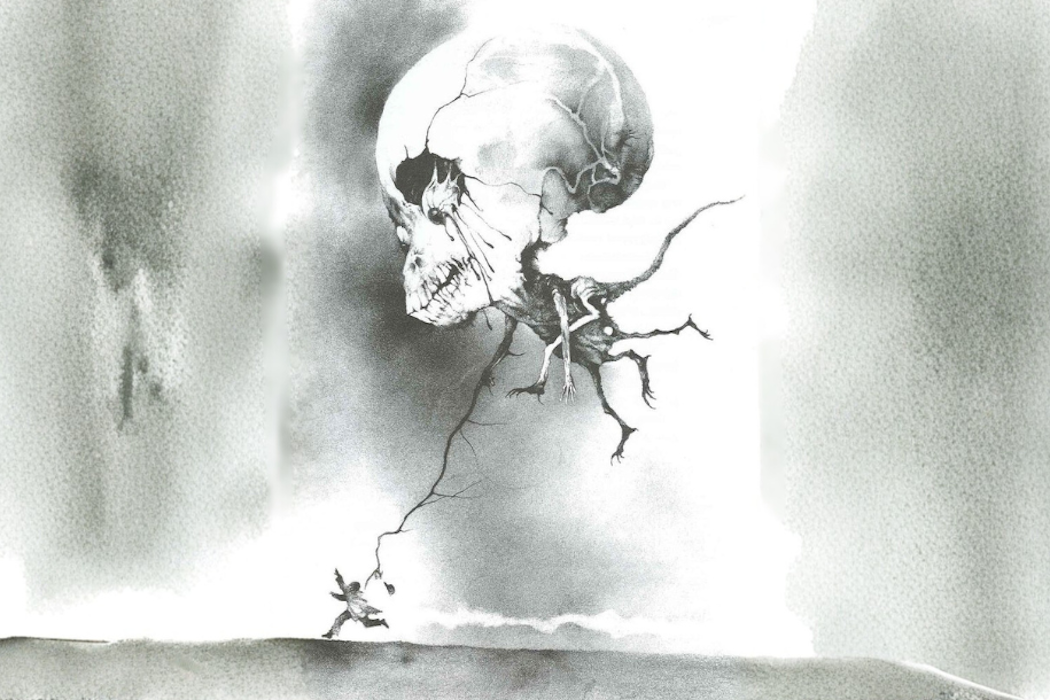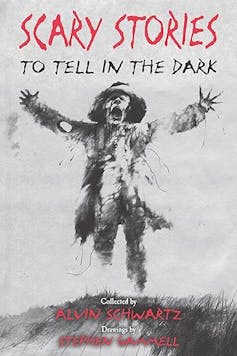
Seeing the cover of Alvin Schwartz’s Scary Stories to Tell in the Dark (1981) has a powerfully Proustian effect on me: my stomach drops a little bit and a shiver of twinned fear and delight runs down my spine, even now, some 35 or so years after I first encountered it as a precocious pre-teen. At the time, I was a voracious and omnivorous reader with an appetite for books that my parents fully encouraged.
My tastes were wide and varied: some of my favourite books from this period included L. M. Montgomery’s Anne of Green Gables series, the Sweet Valley High and The Baby-Sitters Club books. There was also the occasional Agatha Christie crime novel and something from R.L. Stine’s Goosebumps series. The latter two arguably introduced me to that delicious thrill of being frightened by what I read and inspired me to seek out other works with a similar “scare factor”.
I remember buying Scary Stories to Tell in the Dark from the annual scholastic book fair – the highlight of the American elementary school calendar, as far as I was concerned. Schwartz’s collection of tales included 29 stories drawn from diverse sources, from folklore to urban legends to personal interviews.
This article is part of a series of expert recommendations of spooky stories – on screen and in print – for brave young souls. From the surprisingly dark depths of Watership Down to Tim Burton’s delightfully eerie kid-friendly films, there’s a whole haunted world out there just waiting for kids to explore. Dare to dive in here.
They’re short, simply told, and often interactive, instructing young readers to pause, or jump, or scream at specific moments while retelling the stories to their friends. Some of my favourite tales are actually songs, like “Old Woman All Skin and Bone” and “The Hearse Song”, which are accompanied by bars of music and are based on traditional folk songs from Britain and the US.
The stories do deal in some disturbing ideas and imagery, including, for example, dead bodies, the occasional decapitated head or body part and a number of ghosts. However, they are narrated in such a succinct and matter-of-fact manner that the horror associated with the subject matter is effectively mitigated.
Tellingly, ghosts and dead bodies are often met with humour, as in the final six tales of the collection. There is also an emphasis on the dangers of superstition, as in the story “The Girl Who Stood on a Grave”. In it, a young girl accepts a dare to stand on a grave, rejecting her friends’ belief that to do so will mean she’ll be grabbed by the dead person inside.

As she enters the cemetery, she agrees to stab a knife into the ground to prove to her friends that she has done it, but she never returns. Her friends later find her lying on top of the grave, dead from fright having unwittingly pinned her skirt to the ground with the knife and believing she had, in fact, been seized by a cadaver.
The images that accompanied these tales – drawn by illustrator Stephen Gammell – were fabulously gruesome. They heightened the effect of the tales and ensured a suitably scary reading experience. Later editions replaced these images with gentler, alternative illustrations by Brett Helquist – much to the consternation and dismay of earlier readers.
Scary Stories to Tell in the Dark has had a long lasting cultural impact and was adapted to film in 2019, to general, critical and popular acclaim.
Despite its fans, Scary Stories to Tell in the Dark and subsequent collections have not been without controversy. Marketed to young adult readers – among whom they have proven enduringly popular – they have invited fervent and sustained criticism from concerned parents and teachers about their suitability for young readers. Several US schools and libraries have accordingly banned the stories.
My experience of them, however, was an exceptionally positive one: yes, they were occasionally scary, but they were also fun. They were stories to be enjoyed under the covers with a flashlight for best effect, later to be recounted in gory detail to friends at sleepovers.
Scary Stories to Tell in the Dark offers tales that speak to a common human experience, one that brings us to cinemas to sit on the edges of our seats while we peer at the screen through our fingers: the enjoyment to be had from being scared, safe in the knowledge that we ourselves are not in any immediate danger. As Schwartz himself wrote in his preface to the collection: “Telling scary stories is something people have done for thousands of years, for most of us like being scared in that way. Since there isn’t any danger, we think it is fun.”
Scary Stories to Tell in the Dark is suitable for children aged 10 to 12, or possibly mature younger readers.
This article features references to books that have been included for editorial reasons, and may contain links to bookshop.org. If you click on one of the links and go on to buy something from bookshop.org The Conversation UK may earn a commission.
Looking for something good? Cut through the noise with a carefully curated selection of the latest releases, live events and exhibitions, straight to your inbox every fortnight, on Fridays. Sign up here.
Christina Morin does not work for, consult, own shares in or receive funding from any company or organisation that would benefit from this article, and has disclosed no relevant affiliations beyond their academic appointment.
This article was originally published on The Conversation. Read the original article.







